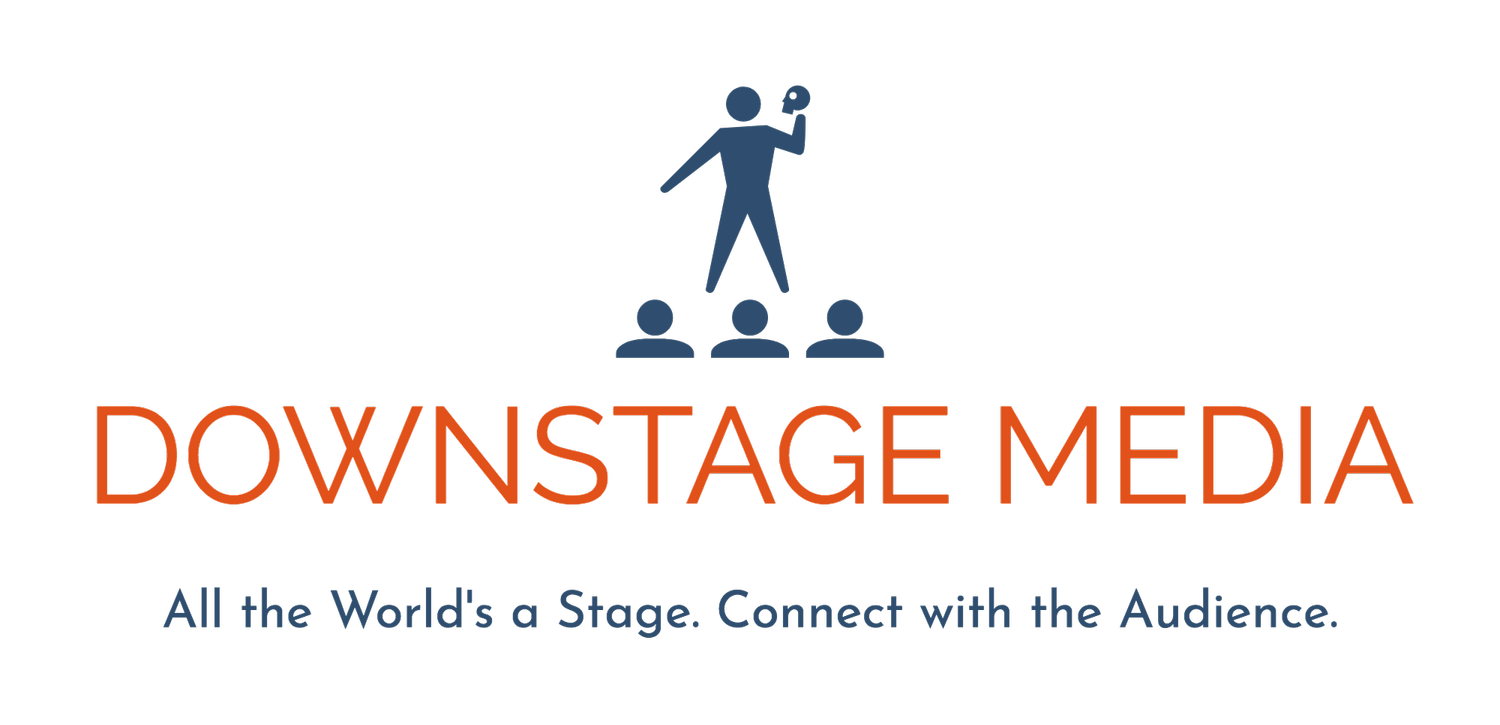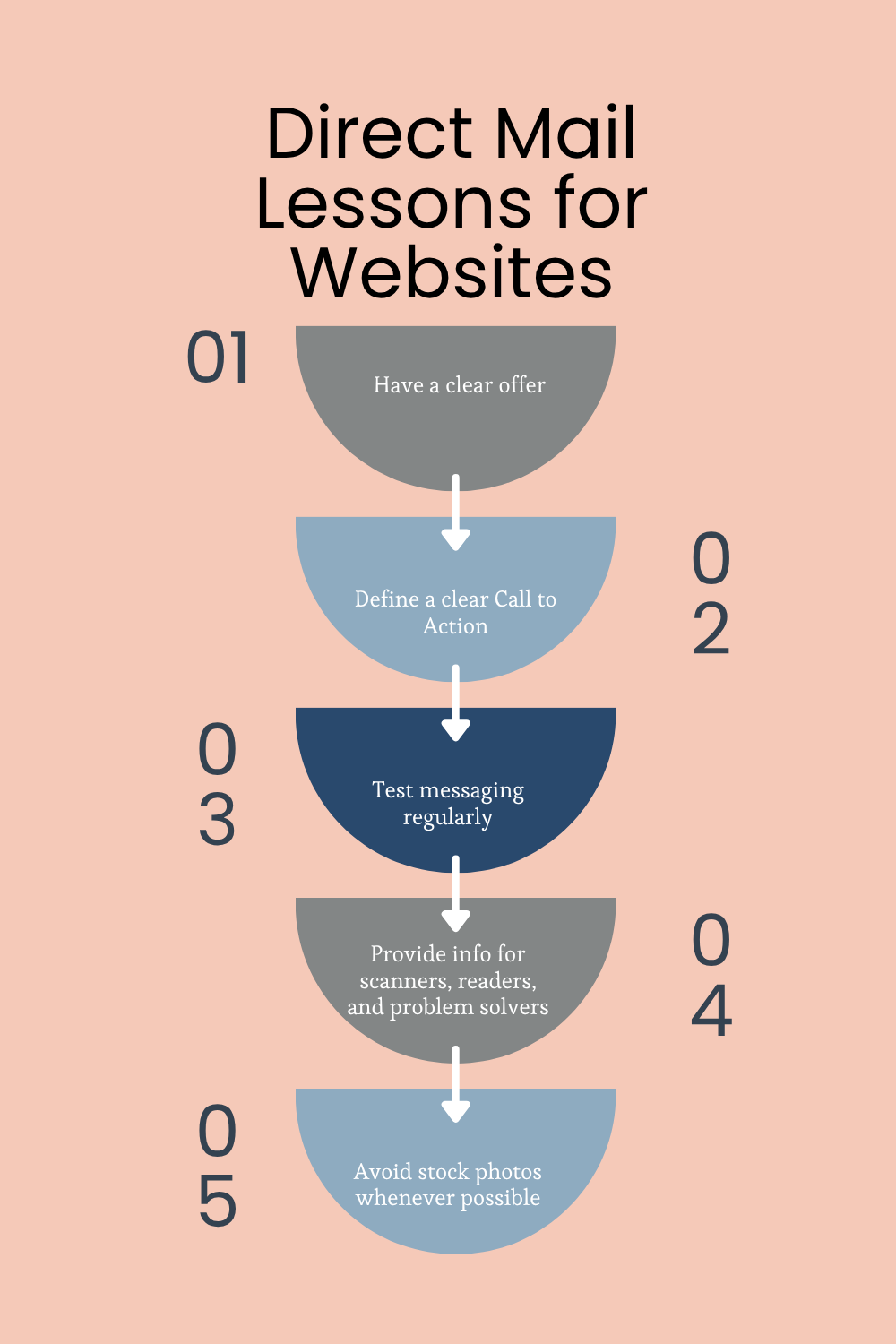What Thought Leaders Can Learn from Junk Mail About Clearer Websites
Overflowing mailboxes show how quickly people decide what to ignore — the same split-second judgment they make on your website.
If you’re a thought leader or the face of your brand, you’ve probably invested in a beautiful website that may not convert the way you want. In this post, web designer Kristin Madeja shows you how direct response marketing principles can help your site move people from “This looks nice” to “I’m ready to book.” You’ll learn about clarity, calls to action, testing, and photography, so your audience takes action.
What the Heck is Direct Response Marketing?
Lessons in “Junk Mail” That Still Matter
Brand Marketing vs Direct Response
Direct Response Lessons to Apply to Your Website Today
Bringing it All Together
Support to Make Your Website Work Harder
If you’re the face of your brand, you’ve likely put a lot of time and energy into your website. It looks good, it reflects your aesthetic, and it probably aligns with your brand values. Yet people still land on it, skim for a few seconds, and leave without taking the next step.
Most thought leaders don’t have a design problem.
They have a clarity problem.
To solve that, it helps to learn from someone who has worked inside the world of direct response. Kristin Madeja is a Squarespace Circle member and StoryBrand Certified Guide, who spent four years sending high-volume direct response mailers that were measured down to the decimal. She learned how people make split second decisions. Now she uses that experience to create websites that convert in seconds.
Thought leaders often struggle with websites that look good but don’t convert. In this video, Kristin Madeja shares the direct mail lessons that fix that fast.
What the Heck is Direct Response Marketing?
Hi, I’m Kristin Madeja. I’m a Squarespace web designer and Circle member who used to be a direct response marketer. Oh, and I’m also a StoryBrand Certified Guide.
Kristin Madeja, StoryBrand Certified Guide and Squarespace Circle member, blends direct response strategy with beautiful, high-converting website design.
If you’re a thought leader, speaker, or business owner who is the face of your brand, you’ve probably mastered one side of the marketing coin: brand marketing. Brand marketing is about emotion. It’s Coca-Cola’s polar bears at Christmas or Apple’s clean stores and minimalist packaging. It’s about how people feel when they encounter your brand.
But there’s another side of the marketing coin. Direct response marketing. This is where clarity meets conversion.
While brand marketing builds connection, direct response marketing asks for the sale. It turns that emotional connection into action. Booking a call, buying a product, joining your program, or hiring you to speak at the next big event.
And here is the good news. The same direct response principles that once helped me sell home security systems through “junk mail” can help your website work harder for you today.
Lessons in Junk Mail That Still Matter
Before I went out on my own, I had what I like to call a “real job.” I sent junk mail for a living. Literally. Envelopes, letters, and postcards, mailed out by the millions every month all across the United States.
We worked for the largest home security company in America, and our job was simple, but not easy. Create the best junk mail possible.
Our goal was to get people to open the envelope, read the letter, and take action. Call the phone number, visit the website, or buy the product. All before they dropped the letter in the trash.
“Each campaign taught me a powerful truth: marketing isn’t about shouting louder. It’s about understanding what moves people to act.”
Because we had so much volume, we could measure how people responded. We knew, for example, that a particular piece would get a 10 percent response. Ten percent of people would see that letter and say, “Yes, I’m going to call. Yes, I’m going to visit the website. Yes, I’m going to buy.”
My whole job was to ask, “Can we beat that? Can we do better? What does it take to be better?”
So we would experiment. What if we changed the envelope? What if we changed the headline? What if we rewrote the letter completely? It became a game of changing the words and changing the design to make it more compelling, easier to understand, and faster to act on.
Each campaign taught me a powerful truth: marketing isn’t about shouting louder. It’s about understanding what moves people to act.
Even today, when most of our “mail” lands in digital inboxes and on websites, these same principles still apply. To your homepage, your brochure, your social media, and your speaking engagements.
Brand Marketing vs Direct Response: Two Sides of the Same Coin
There’s brand marketing, which most of us know and love. It’s warm, emotional, and memorable. It’s how we feel when we walk into the Apple Store and open that iPhone box. Brand marketing builds trust.
“If it’s not clear how to do business with you, you’re missing out in a huge way on your website.”
But we forget that our websites are about driving sales.
Your website needs to do more than create an emotional response. It needs to get people to contact you. Fill out a form. Book you to speak. Join your program. Buy the thing.
That means at some point you need to look your audience in the eye, metaphorically, and say, “Hey, I’m here to help you. I’m here to serve you. I’m here to provide a service. And this is how to do business with me.”
If it’s not clear how to do business with you, you’re missing out in a huge way on your website.
Brand marketing and direct response are two sides of the same coin. You need both. The feelings and the follow-through.
Here are some of the direct response lessons I learned from sending junk mail that can make a real difference on your website.
Direct Response Lessons You Can Apply to Your Website Today
Think of these as five questions to ask yourself to strengthen your marketing and turn more of your audience into clients.
1. Is Your Offer Clear?
If someone lands on your homepage, can they tell in five seconds:
Who you are
What problem you solve
How they can do business with you
If not, it’s time to simplify.
Donald Miller calls this the “Grunt Test” in his book Building a StoryBrand 2.0. If a caveman looked at your website, would they grunt in recognition of what you offer?
In my home security days, we literally tested this. One mailer said, “Get home security today.” The other said, “Get a doorbell and feel safer.” The one that said “home security” clearly and directly won over and over again.
We knew we were selling home security. We were the internal creative team. We lived and breathed it. But we still had to say it clearly, because people don’t remember what you sell unless you keep reminding them.
Your offer should be obvious at the top of your homepage, in your bio, and anywhere your name appears. Clarity converts.
Ask yourself:
Would a brand-new visitor know what I actually sell just by glancing at the top of my site?
If the answer is no, start there.
2. Do You Have a Clear Call to Action (CTA)?
If you’re going to a website to buy something, you need to know where to do that. And you need to find it fast.
If the button to book you is buried at the bottom of the page, if the “Work with me” link is hidden in the navigation, or if there is no obvious next step, people will not go hunting. They will leave.
Your CTA might be:
Book a Call
Hire Me to Speak
Enroll Now
Don’t hide your CTA. Put it in your website header, near the top of your homepage, and again as people scroll. You’re not ending the sale at the top of the page, but you are starting it and reminding people how to continue.
And if you prefer a particular way of being contacted, say that. If you love text, make that the big CTA. If you prefer a form or a phone call, make that primary, then show secondary options in smaller ways
Different people respond in different ways. Make it easy for all of them.
3. Are You Testing the Right Things?
You may have heard a lot about A/B testing. Red button versus green button. This headline versus that one. And when you’re a huge company with tons of traffic, a 1% increase in response can be amazing.
But most of us are not Nike. We don’t have that kind of web traffic.
This infographic highlights the five direct response lessons Kristin Madeja recommends for building clearer, higher-converting websites.
For small businesses and thought leaders, testing tiny details often won’t tell you much. Instead, you want to test bigger creative changes.
In direct mail, we didn’t test swapping one adjective for another. We tested completely different letters. A brand new creative concept. That is where we saw 50, 60, 70, even 80% changes in response rates!
On your website, that might look like:
A completely different hero headline
A new hero image that changes the emotional tone
A different opening paragraph that names the problem more clearly
The beautiful thing about the web is that nothing is permanent. You can put something up, let it sit for three to five months, listen to your clients, notice what they say back to you, and then adjust.
Ask yourself:
Is it time to try a new headline or hero section and see how people respond?
4. Are You Speaking to All Three Types of People?
Forget personality tests for a second. When it comes to your website visitors, there are really three types of people:
Scanners skim headlines and bullet points.
Readers want details and supporting text.
“What’s in it for me?” people only care about how you solve their problem.
Your website needs to serve all three.
That means:
Clear, simple headlines for scanners
Short paragraphs and a bit more detail for readers
Strong problem-solution clarity for the “WIIFM” group
This is where the StoryBrand framework shines. You show empathy for your audience’s problem, then clearly present your solution and the path to get there.
When in doubt, ask:
Am I making it easy for each type of visitor to see themselves in this story and know what to do next?
5. Are You Showing Yourself (Literally)?
Authenticity stands out. Especially now.
If you are the face of your brand, your website imagery needs to show that.
I believe that because of AI, we need more humanness in the world. We need to see you doing your best work and being your amazing self.
If you’re a keynote speaker, we need to see you on stage. If you work with clients, we need to see you in conversation. Your speaking engagement is a product that deserves its own dedicated photos.
“People buy from people. Show up as you.”
Invest in professional photos that:
Show you in action — speaking, brainstorming, working with clients
Include horizontal shots for your website (with room for text)
Include vertical shots for social media
Reflect your energy and authority
People buy from people. Show up as you.
Bringing it All Together
Direct response marketing isn’t about being salesy. It’s about being clear, human, and intentional.
As thought leaders and business owners, our audiences already like us. Brand marketing did that. It gave them a reason to feel connected.
Direct response marketing helps them take the next step. To work with us, hire us, or buy from us.
So ask yourself:
Is my offer clear?
Do I have a strong, obvious call to action?
Am I testing the right things?
Am I speaking to scanners, readers, and “What’s in it for me?” people?
Am I showing up authentically with real photos of myself?
When you align those answers, your websites capitalizes on what direct response marketers have known for decades.
Support to Make Your Website Work Harder
If you’re reading this and thinking, “I know my site could be clearer, but I’m not sure what to say or what content to create next,” you don’t have to figure it out alone.
I’ve partnered with Downstage Media so that once you work with Annie Figenshu to decide what belongs on your site, on your blog, and in your content rhythm. Then, when you’re ready, I or another trusted designer can put that message on a site that works.
Book a call with Downstage Media to get clear on your content and strategy.
From there, your website, your marketing, and all that beautiful brand work finally start pulling in the same direction























